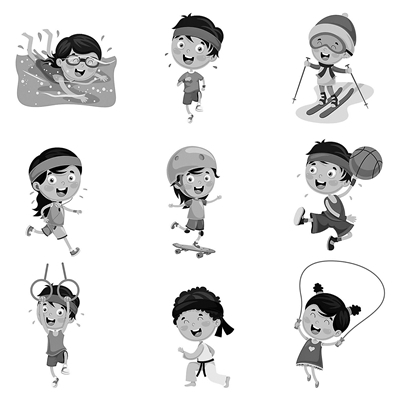Come and watch sports. That’s how the baby becomes smart.

Are there any children around you who are obviously locked up at home by their parents to study all day, but their grades are getting old? It should be a sunny and lively age, but it seems listless and dull. Parents can’t help but wonder: "Is my child too stupid?"
How to make children smarter is the common wish of parents. Today, doctors from Peking Union Medical College Hospital will recommend an "artifact" for you to strengthen your brain, which requires no money and no side effects. You only need to spare a little time every day to achieve the purpose of strengthening your brain. Come and find out — —
Exercise is the booster of learning.
Many parents think that sports will delay their children’s study, but many studies have shown that sports may help them improve their study.
The benefits of exercise are all-round, which can not only strengthen heart and lung function, increase muscle strength, promote bone growth, make children healthier and more energetic, but also help children develop the habit of independence, persistence and self-discipline and a positive attitude.
As early as 2009, a survey among more than 2200 fifth-grade students in Shanghai found that children with exercise habits tend to get better grades; In 2017, scholars from Spain, Italy and Chile analyzed 26 research data (covering children aged 4 to 13) and concluded that physical activity can improve learning ability, especially in mathematics and reading.
Studies have shown that exercise can improve the ability to divert and concentrate for at least two hours. After exercise, children gain a happy mood, as well as better memory, concentration and responsiveness, which is undoubtedly very beneficial to learning.
The World Health Organization (WHO) states that regular exercise can not only protect children’s health, but also improve their academic performance.
This is how exercise changes the brain.
The effects of exercise on the brain can be divided into short-term and long-term categories.
In the short term, exercise will increase some chemicals in the brain, such as dopamine, which will make people feel happy and get a positive and active learning state; Serotonin releases stress and improves memory; Norepinephrine can improve reaction speed and concentration.
In the long run, exercise can change the structure and function of the brain. The "Human Brain Project" initiated by the National Institutes of Health in the United States found in the study that insisting on exercise can obviously increase the number of nerve cells and make the brain stronger and stronger like a muscle.
This phenomenon may come from a substance called brain-derived neurotrophic factor (BDNF), which has the function of maintaining the vitality of existing nerve cells and promoting the growth of new nerve cells. In the brain, BDNF is active in the prefrontal lobe and hippocampus. The frontal lobe is located behind our forehead and controls decision-making, attention and personality; Hippocampus is located deep in the temporal lobe of our brain, which plays an important role in the formation and storage of long-term memory.
A study in 2013 showed that only 20 to 40 minutes of aerobic exercise (such as walking and jogging) can increase BDNF in the blood by about 32%. Therefore, exercise will not only affect academic performance, but also improve learning efficiency, make children’s thinking more sensitive and focused, and remember things faster and more firmly.
Choose the most suitable exercise for children.
So, what sports are suitable for children of different ages? Come and find out.
Under 2 years old, because the child’s heart, lungs, spine, bones, etc. are not fully developed, simple sports can be carried out, such as turning over, crawling and training activities of limbs.
Children aged 3 to 6 are in the golden age of coordination, agility and flexibility. They can try cycling, climbing, skipping rope and playing football, but they are not suitable for highly antagonistic events such as basketball.
Parents aged 6-12 can take their children to run or swim, and they can also add some simple confrontation events, such as fencing and taekwondo, or do some small strength training, such as sit-ups and dumb bell exercises.
After entering puberty at the age of 13 to 18, children’s bone and muscle mass have surged, and their explosive power, speed and endurance have all increased rapidly. At this time, parents can choose physical sports such as running, swimming, high jump and long jump, as well as skilled sports such as basketball, football, gymnastics and dance according to their children’s interests, and encourage them to contact different kinds of sports, which can promote brain development more effectively.
Tips
This exercise gets twice the result with half the effort.
How to exercise is most beneficial to children’s health? The Physical Activity Guide for Children and Adolescents in China suggests that children and adolescents aged 6 to 17 should have at least 60 minutes of moderate and high-intensity physical activity every day.
During moderate-intensity exercise such as brisk walking, breathing and heart rate increase, but you can still talk; During high-intensity exercise, such as running, breathing and heart rate increase greatly, making it impossible to talk.
It should be noted that after the child recovers from the disease, the exercise intensity must be gradual, such as walking to brisk walking, and then jogging, giving the body time to fully recover.
Text/Angelnan (Peking Union Medical College Hospital)